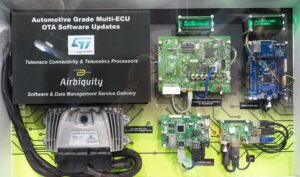Mobile World Congress originated in Madrid in 1987 as GSM World Congress and moved as it’s grown to Cannes and now to Barcelona. It has also expanded from being focused uniquely on GSM phones, to mobile devices, and now to any connected device. This year, the halls of the Fira Gran Via Exhibition Center are paved to accommodate more and more cars, as automotive manufacturers make their tech presence felt. The connected car has laid claim to its place in the mobile world.
BMW, Ford, Mercedes-Benz, Peugeot, and Seat all came to Barcelona to show their vision of the connected car of the future. And vehicle manufacturers weren’t the only ones showing off their gleaming creations: many of the major telecoms were doing it too. The telecoms leaders highlighted how their networks would soon seamlessly integrate the connected cars of today and provide a host of new services to those of the future. The 108,000 visitors to Mobile World Congress couldn’t miss the demonstrations and applications from numerous companies targeting automotive manufacturers with more and better connectivity options or services. The goal for all: build safer, greener, and more convenient transport thanks to the data that the connectivity will provide via the cloud.
ST is contributing to this vision and we showcased some of the technology that is already shaping the connected autonomous cars of the future. For the first time at Mobile World Congress, we presented a dedicated demonstration pod showing the use cases that ST components enable. For example, we showed examples of ST’s Smart Driving Connectivity solutions like Vehicle-to-Vehicle communications that are making driving safer by enabling vehicles to communicate potential hazards to cars and trucks following behind them. Other use cases showed how ST’s sensors and ICs can alert emergency services in the event of an accident, reduce traffic congestion by providing accurate positioning, and share data using cloud connectivity for real-time navigation services.
Of course, secure connectivity is important, so ST demonstrated its automotive-grade hardware-secured telematics processors and microcontrollers, supported by dedicated secure elements. All part of ST’s consistent approach to keep car hackers at bay.
The MWC demonstration complemented each of the animated application use cases with a block diagram populated with ST’s complete range of relevant ICs. These provided the more technical-minded visitors with the opportunity to discuss in detail with ST experts on hand how these products will enable features in the connected cars of the future.

The connectivity of modern vehicles makes them increasingly dependent on electronic control units (ECUs) and microcontrollers. The rising intricacy and complexity of managing software updates and data collection for millions of vehicles around the world is becoming a key challenge. To address this, we invited our partner Airbiquity to demonstrate their solution, which provides real-time software update over-the-air (SOTA) for vehicles and has already been used to provide nearly 4 million updates in over 50 countries around the world. The live demonstration used a combination of automotive-grade high-performance telematics processors and ECUs from ST and robust and secure over-the-air (OTA) software and data management from Airbiquity.
The theme for the 2017 edition of Mobile World Congress was “the Next Element”, and it seems that the next element in the Mobile World really is the Connected Car
